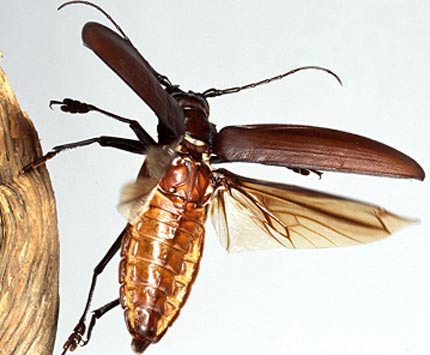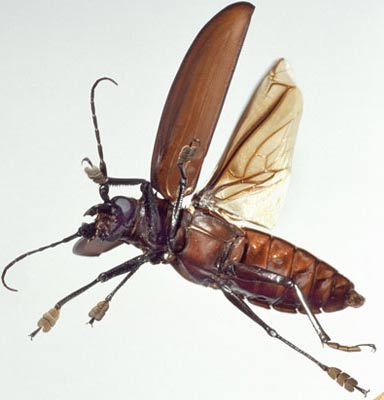Titan Beetle – World’s Largest Beetle

The titan beetle is the world’s largest species of beetle. It has been mistakenly classified as a giant cockroach by some people, but it is a pure beetle, with a genus of its own, Titanus. It is a member of the Cerambycidae family, or “longhorn beetles”. Adults grow as long as 16.7 cm (6.5 in) and their mandibles are strong enough to snap a pencil in half, or cause damage to a person’s flesh.
Restricted Habitat
This huge beetle is the longest known beetle in the Amazon rainforest and is found in French Guiana, north Brazil and Columbia. The beetle is only found in the hot, humid regions around the tropics, very near to the equator. The larvae of these beetles feed on dead wood, below the surface of the ground. They look weird, resembling sections of vacuum cleaner hose and are also big.

Because titan beetle larvae feed on large chunks of wood, they need to live in regions where there is plenty of hard, indigenous wood from huge trees available. The shrinking population of these beetles, is mainly due to habitat destruction from the timber industry.
Life Cycle
As is the case with the large atlas moth, the titan beetle does not feed in its adult phase, it simply flies around long enough to find a mate and reproduce. The pupae have apparently never been found. It is likely that they reach maturity inside roots and branches underground. It is thought that they take many years to reach a large enough size before they pupate. Boreholes have been found in wood that indicate that the titan beetle grubs are two inches wide and up to a foot long.

After dark, bright lights attract these beetles. Mercury-vapor lamps, in particular, are used to attract male titan beetles in French Guiana. There is an eco-tourism industry based on providing sightings and specimens of these beetles in villages in the region. Specimens fetch up to US $500 per beetle.
Getting Protection via Collectors
Although it seems contradictory, the beetle’s value with collectors is what is providing necessary funding and awareness for its conservation. Because titan beetles are so dependent on “good quality wood” for survival, it is not just the beetles that benefit from conservation efforts, but the entire ecosystem that surrounds their living environment. Females are very difficult to collect, and males are thus the ones that are trapped by locals and sold to collectors. This does not hurt the overall population much at all, since males are just needed to fertilize the females’ eggs.
